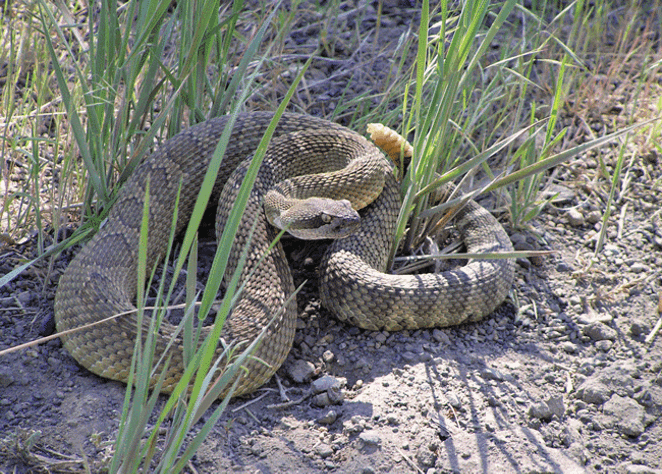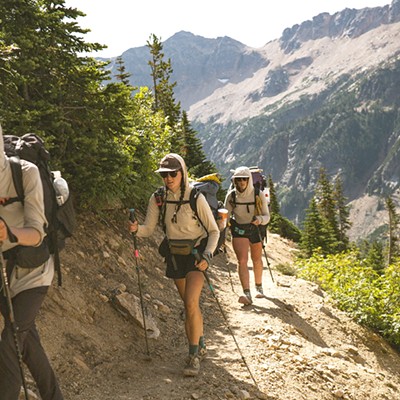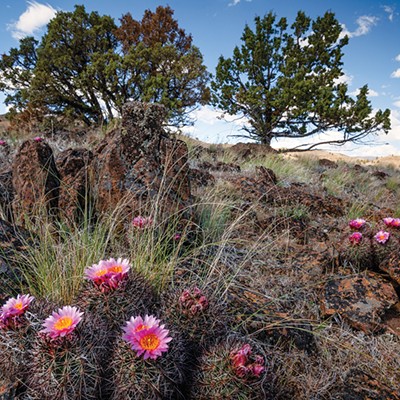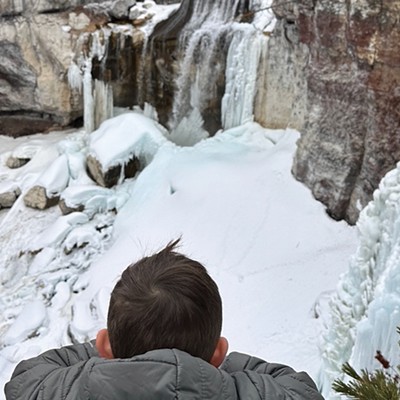From the first day I set foot in Oregon—literally—rattlesnakes came into my life. It took place after I was leaving the old Hampton Station, out east of Bend on Highway 20, having stopped there for a cold Pepsi. It was the last week in September and a huge line of thunderstorms was ahead of me on and above that glorious snow-capped Cascade skyline, and I was wondering what Bend would be like.
As my old 1947 Harley carried me past the Millican store I spotted a snake starting across the pavement. I've always had a curious nature about snakes, so I cut back on the throttle—and I can still hear that magnificent sound of that Harley engine purring down—applied brakes and went by the snake slowly.
I could see it was a rattler, my first one for Oregon. How could I resist? I brought the old Harley to a stop, pushed out the kickstand and ran back to get a closeup view.
Yep, it was a big one with a good-sized rattle, which went erect and started shaking as I came close to it. What a sight! What a sound! What a thrill! Oh, how I wished my camera wasn't out of film. That snake was posing for me and I think I even saw a big grin on his face...
From that day on, Oregon's rattlesnakes were my close friends, and every opportunity I had to share that unconditional love for them was a gift from On High. Not everyone remembers that their main source of protein comes from the small—and destructive—rodents they prey on. Can't beat that with a stick... They also possess a built-in warning system that most humans recognize and do all they can to avoid.
And they do not go out of their way to inject venom in people like they do obnoxious rodents. Yes, a coiled rattler can generally strike the distance of about half its body length, and if you stand there and get bit...well... .
So, if you're near a nice body of water in the warm months with lots of brush, or a rocky hillside, keep a thought in your mind about buzztails, and if you hear one, stop and think—not about killing it, please—but about both of you going home peacefully.
When I went to work for Oregon Museum of Science and Industry as science teacher, camp director, bus driver, photographer and staff naturalist, many wonderful opportunities came to me to share that love of snakes and do everything I could to impart a keen sense of curiosity and respect in young people, especially at Camp Hancock.
The entire staff of that marvelous camp was all for snakes, fossilized or living. I was sent over to Hancock to open it up and be the boss at times when the regular camp director couldn't get there until after the last week of school. When that was over I'd take the old 26-passenger Ford bus the museum called "The Space Cruiser" full of kids of all ages on science trips all around Oregon and the West. And I got paid to do it!
Well, one day in the mid-'60s while headed for Bend on Highway 97 with my new wife, Harriet, and our brand new son, Dean (whose oldest married daughter, Mary-Catherine, just made me a Great Grandpa two days before my 94th birthday), a state policeman came up behind me with siren blaring and blue lights flashing.
I had just come to a stop, and he was already at my side window asking, "Are you James Oscar Anderson Jr.?" When I replied that I was, he said, "Please follow me, you have to make an emergency phone call to Salem." And away we went, him up front with siren wailing, blue lights flashing and me right behind him.
The first pay phone we came to was at Deschutes Junction. He handed me a piece of paper with a number on it, "That's the number for the Salem Hospital, ask for Dr. McCallum."
I did as instructed and within a few minutes I was talking to the doctor. I had never met him, but knew his wife, a nurse who was also the Camp Hancock camp nurse.
He said, "Jim, my wife tells me you've just returned from a venomous animal symposium in Arizona; what's the latest treatment for rattlesnake bite?" I thought about that for a minute.
"I think it's tourniquet, cut and suck and horse serum if available," and then I added, "What's up?"
"Oh," he replied, "I have a 16-year-old kid from McMinnville who was bitten by a rattlesnake while reaching under a rock to capture it."
"Where on his hand was he bitten?" I asked.
"On the end of his finger," he replied.
"If that's Al St. John," I said, "tell him to live with it and suffer; from what I've heard he's been doing that since he was 6 years old!"
Well, St. John survived that one and others like it over the years, and today he's Oregon's best-known, best-read, best-informed herpetologist. He's authored a wonderful field guide, "Reptiles of the Northwest: California to Alaska, Rockies to the Coast," and numerous articles on the range and welfare of these fascinating creatures.
And I probably wouldn't get away with telling this story if he wasn't one of my dearest old pals.























